Surprising and rich in picturesque natural beauty, the Abkhazian land is perhaps one of the most interesting places in the Caucasus. In this small unrecognized country, Orthodox churches have been standing for more than a thousand years, and ancient fortresses still remember the invasion of the Ottoman Turks. At the beginning of the 20th century, Abkhazia began to develop as a resort, in a short time, having won the glory of the “Russian Monaco”.
It is amazing, but such a small area hosts a huge number of valuable architectural monuments and natural attractions. Here is Lake Ritsa, and the famous New Athos Monastery, and the Anakopia Fortress. No less attractive for travelers are the castle of Prince of Oldenburg, the legendary Gagripsh restaurant, and the Abkhaz State Museum.
What to see and where to go in Abkhazia?
The most interesting and beautiful places for walking. Photos and a short description.
- New Athos Monastery
- Lake Ritsa
- Blue Lake
- Anakopia fortress
- Abaata fortress
- Gagra colonnade
- Seaside Park (Gagra)
- Sukhumi Botanical Garden
- Castle of the Prince of Oldenburg
- I.V. Stalin's dachas
- Abkhaz State Museum
- Restaurant Gagripsh
- Lykhny temple
- Bedia Cathedral
- Patriarchal Cathedral in Pitsunda
- Koman Monastery
- Sukhumi monkey nursery
- Besletsky bridge
- Yupshar Canyon
- Mount Mamdzyshkha
- New Athos cave
- Alpine meadows of Abkhazia
- Waterfall Girl's Tears
- New Athos waterfall
- Geg waterfall
New Athos Monastery
The New Athos monastery was founded in 1875 by monks from Old Athos, located in Greece, with the support of Tsar Alexander III. The complex includes six temples, each of which is distinguished by original architecture with clearly predominant features of the colorful Byzantine style, which is strikingly different from traditional Russian architecture. The monastery is a popular tourist attraction and pilgrimage site.

Lake Ritsa
A mountain lake located at an altitude of almost 1 thousand meters among the wooded mountains in the basin of the Bzyb River. A picturesque road leads from the Black Sea coast to the reservoir. The territory of the Ritsa and adjacent shores is included in the Ritsa Reserve. The lake is especially picturesque in winter, when its waters acquire a cold blue color. This place is sure to be visited by all tourists vacationing in Abkhazia.
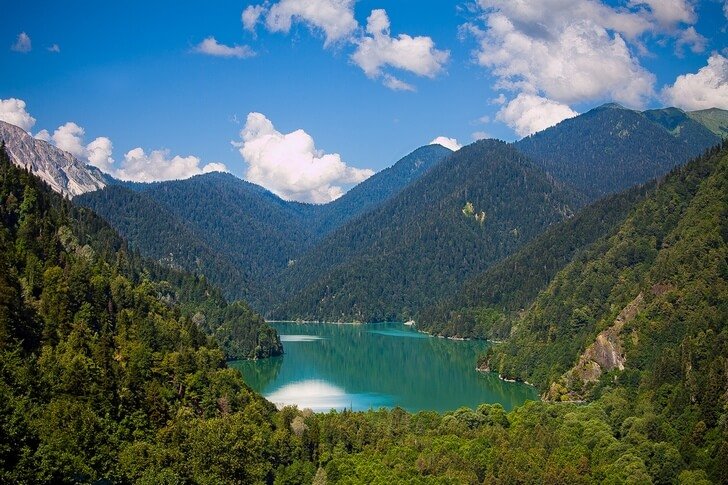
Blue Lake
Karst reservoir, located on the way to the Ritsa. Its waters are distinguished by a bright blue hue and do not freeze even in winter. The lake is filled with an underground river, there is a whirlpool at its bottom. Two legends are connected with its appearance: the first tells about an old hermit who lived in a cave that was on the site of the lake, the other tells about a powerful mistress of the waters. There is also a superstition that if you wash yourself with local water, you can look younger.
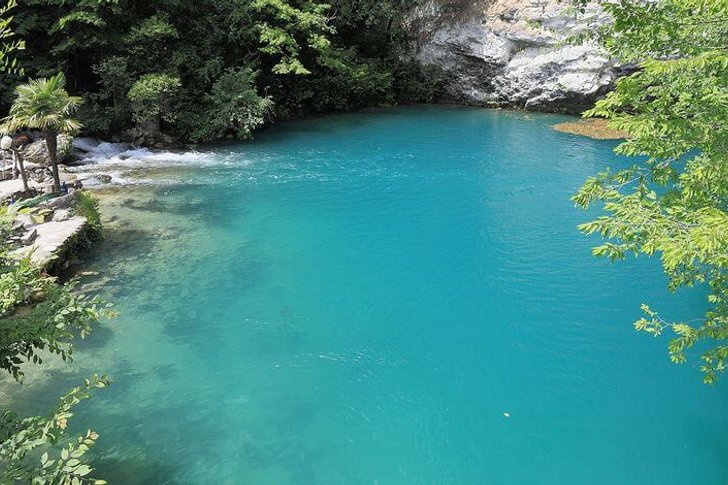
Anakopia fortress
A defensive structure of the 7th century, located on the territory of the city of New Athos. The building was erected with the participation of Byzantine masters in order to protect the borders from the Arab invasion. The legend says that the fortress was besieged by the army of many thousands of Caliph Murvan-ibn-Muhammed, but could not take it. In the XIV century, under the Genoese, a watchtower was built. The ruins of an ancient bastion have survived to this day.
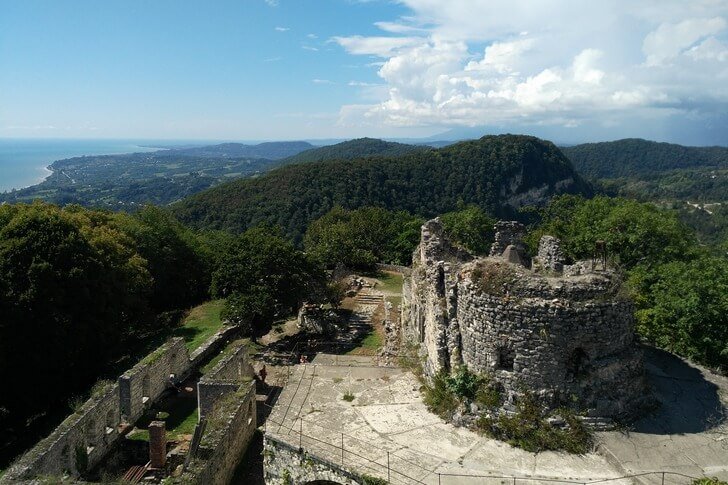
Abaata fortress
The construction of the 5th-6th centuries, which previously served to protect the approach from the Zhoekvarsky gorge. Over the following centuries, it was repeatedly destroyed and restored, as the Genoese, Russians and Abkhazians tried to take possession of it more than once. The fortress has reached our days in a ruined state. Today, the bastion is part of an architectural complex that includes a temple, a restaurant, a hotel and a beach with a park.
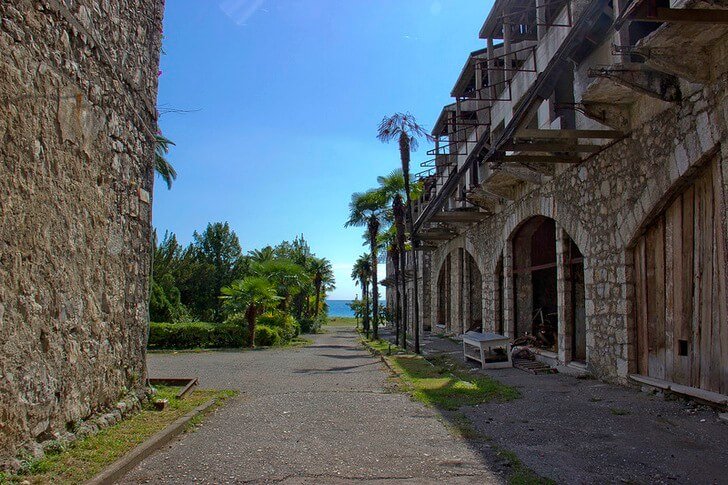
Gagra colonnade
A picturesque enfilade located in the Old Gagra area next to the Seaside Park. The design is considered the hallmark of Abkhazia. The platform in front of the colonnade overlooks the city beach. The structure reaches a length of 60 meters and consists of small arcades of 8 arches each, separated by towers. During the season, it is quite crowded due to the ubiquitous merchants and tourists.
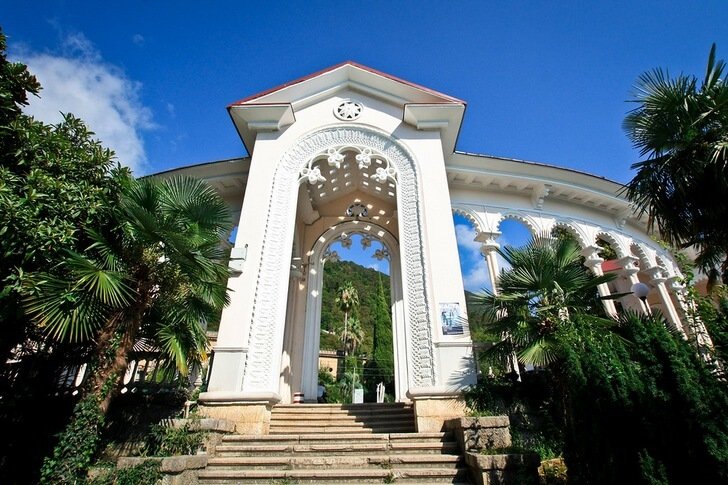
Seaside Park (Gagra)
Arboretum, planted with typical tropical vegetation, is the best place for walking and relaxing from the scorching sun. It was founded at the beginning of the 20th century; plants for it were brought from different parts of the world: Asia, Australia, South America and the Middle East. Gardeners had to make remarkable efforts to take root in an unusual climate. In total, more than 400 species grow here.

Sukhumi Botanical Garden
One of the oldest botanical gardens in the Caucasus, founded in 1838. In the 19th century, it was destroyed twice by the Turks during the Russian-Turkish wars, and great damage was done to the plantings during the Georgian-Abkhaz conflict of 1992-93 - most of the rare plants died. With the onset of peace, the employees immediately took up the restoration of the territory. Today, more than 5,000 trees, shrubs and herbs grow in the garden.
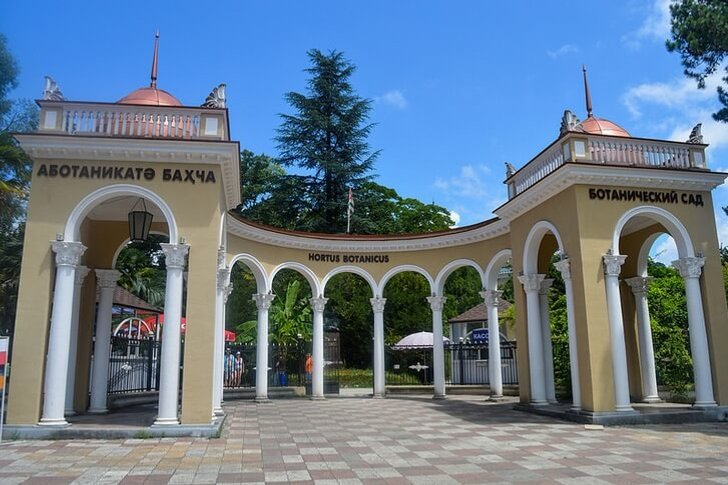
Castle of the Prince of Oldenburg
The palace was erected in 1902 according to the project of I. K. Lyutseransky in the Art Nouveau style. It was built for A.P. Oldenburgsky, who was engaged in the improvement of the Black Sea coast on behalf of Emperor Nicholas II. The road to the residence passes through the Seaside Park. The once picturesque building with towers, white walls, pretty balconies and decorative railings is now in a deplorable state.
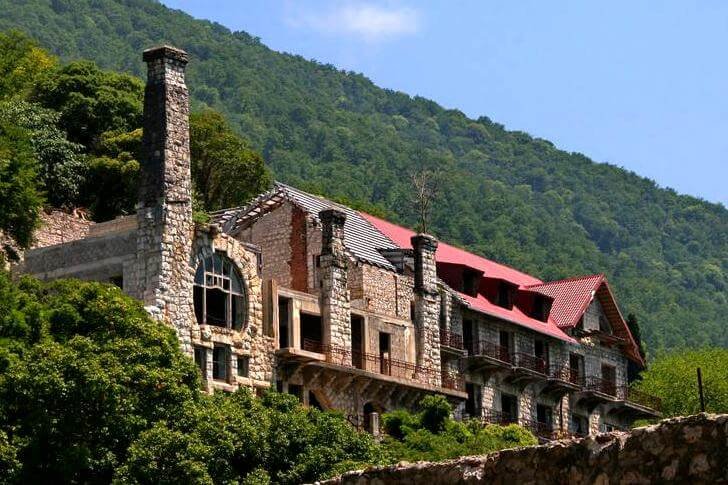
I.V. Stalin's dachas
In Abkhazia there are as many as five dachas of the Soviet leader: on the Cold River, 15 km. from Gagra, in the Pitsundo-Myussersky reserve, not far from the New Athos monastery, on Lake Ritsa and in Sukhum. Today all buildings are available for visiting. The Father of Nations, apparently, had a special love for Abkhazia, since he preferred to place such a large number of his residences here.

Abkhaz State Museum
The museum opened at the beginning of the 20th century and soon became a real gem of the region, which was very popular far beyond the borders of Abkhazia. Even today it retains its cultural significance and historical significance for the revival of the heritage of the peoples of the Caucasus. The collection consists of 170 thousand exhibits, some of them are millions and thousands of years old. The museum has several branches, among which there is an art gallery.
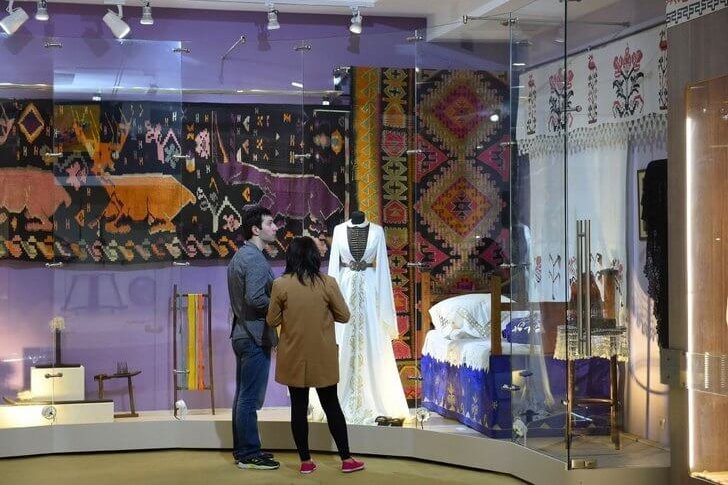
Restaurant "Gagripsh"
The restaurant was bought by the founder of the Gagra resort, Prince A.P. Oldenburgsky at the World Exhibition in Paris. In 1902 it was brought to Gagra, in 1903 it was assembled without the use of nails. This legendary place was visited by Nicholas II, writers M. Gorky, A. P. Chekhov, I. A. Bunin, singer F. I. Chaliapin. It can even be said that the golden age of Gagra as a seaside resort began with the restaurant. The exterior and interior fully convey the spirit of that era.
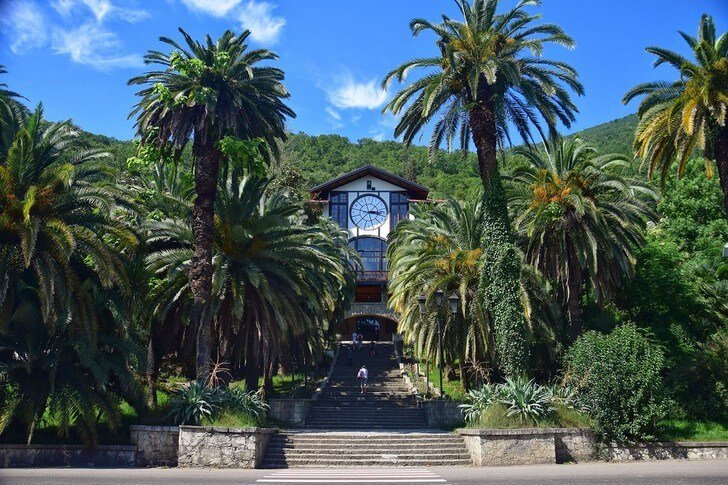
Lykhny temple
The church is located in the village of Lykhny. It is one of the most revered and ancient temples in Abkhazia. The structure was erected in the X-XI centuries; architecturally, it belongs to the early medieval cross-domed buildings. Inside are well-preserved frescoes from the 14th century and several valuable icons. Also here is the grave of Prince George II Shervashidze.
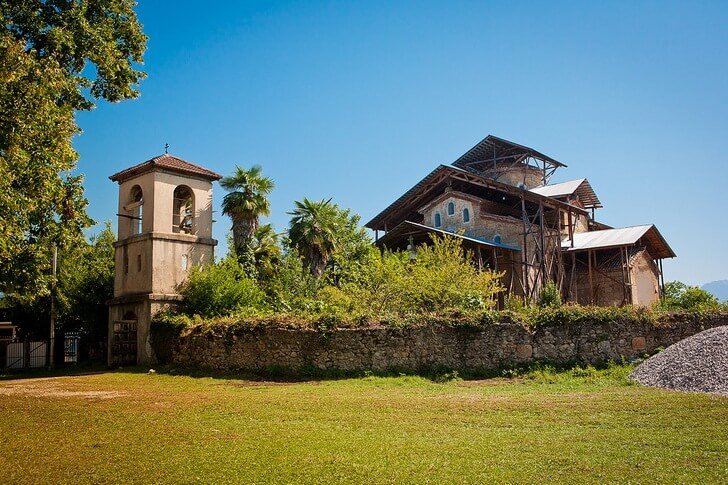
Bedia Cathedral
A medieval temple, a vivid example of the Georgian-Abkhazian architecture of the 10th century, which was built under King Bagrat II. Here the ruler was buried. It is known that in the XIII century the restoration of the building was carried out. From the 17th century, services ceased and were resumed only after 200 years. Three layers of frescoes were discovered inside, presumably created in the 11th, 14th and 16th centuries. Unfortunately, most of them have been lost.
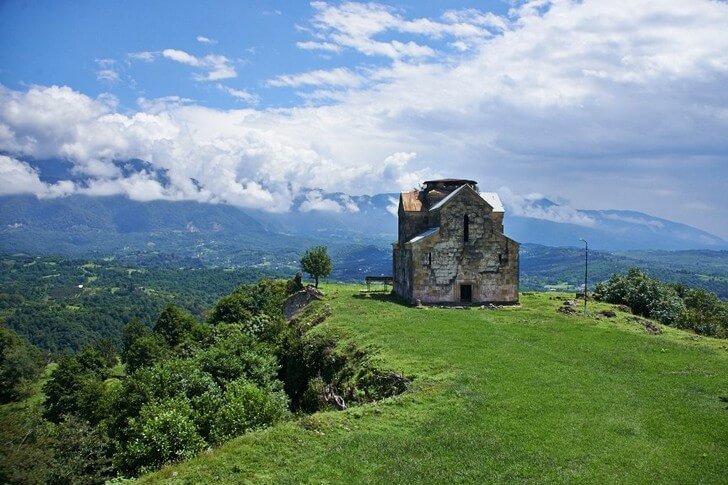
Patriarchal Cathedral in Pitsunda
Temple of the 10th century, erected under King Bagrat III. In the following centuries, the building was rebuilt several times. In the 17th century, worship services ceased here, and all the priests moved to Gelati, along with the chair of the Catholicoses of Abkhazia. After 200 years, the temple was restored and re-consecrated in honor of the Assumption of the Virgin. Inside, the relics of St. Andrew the First-Called and Simon the Zealot are kept in a stone tomb.
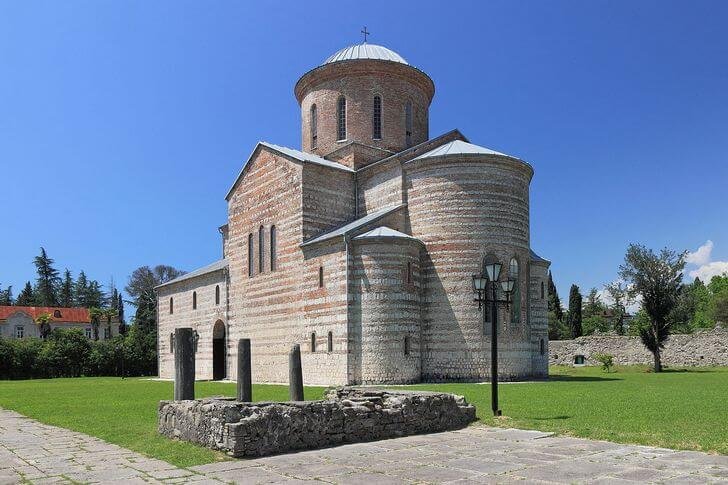
Koman Monastery
An Orthodox male monastery founded in the 11th century, a well-known place of pilgrimage (several tens of thousands of people visit the complex every year). The monastery was built on the very spot where the burial place of John Chrysostom was located. Today, the complex is run by the unrecognized Abkhazian Orthodox Church; monastic life resumed here in 2001 after a long break.

Sukhumi monkey nursery
This is not a harmless menagerie for tourists, although it also performs these functions. It was created in Soviet times on the initiative of the famous doctor and statesman N. A. Semashko. There are research laboratories in which experiments are carried out on animals, testing the effect of various drugs. Sightseeing tours are organized for everyone.
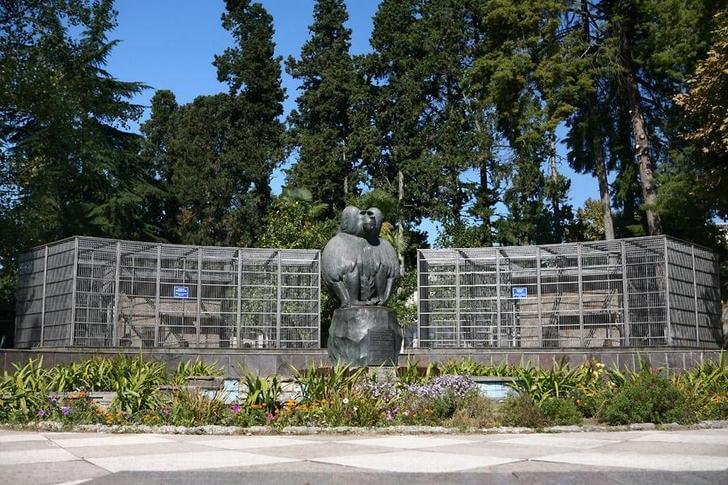
Besletsky bridge
Another name for the building is the bridge of Queen Tamara. It is a 13-meter limestone arch spanning the Basla River. On one of the side parts of the building there is an ancient Georgian inscription, supposedly from the 11th-12th centuries, praising Christ. Several centuries ago, the path to the mountain valleys passed along the Beslet bridge, which was of great strategic importance.

Yupshar Canyon
Through the gorge there is a picturesque path to Lake Ritsa. Sometimes the canyon is called the "Stone Bag" because of the large number of bottlenecks that do not exceed 30 meters in width. For example, the distance between the rocks in a place called the Yupshar Gate is only 20 meters. The mountain slopes of the canyon are covered with ivy, boxwood groves and moss, which create a continuous living carpet.

Mount Mamdzyshkha
The peak is more than 1800 meters high, located a few kilometers from the city of Gagra. It gives rise to the mountain range of the same name. Its slopes are covered with solid green thickets, impassable in many places. At the very top, on the contrary, only grass grows due to constant strong winds. Most of the year (8 months) the mountain is covered with snow, the rest of the time you can get here on horseback or UAZ.
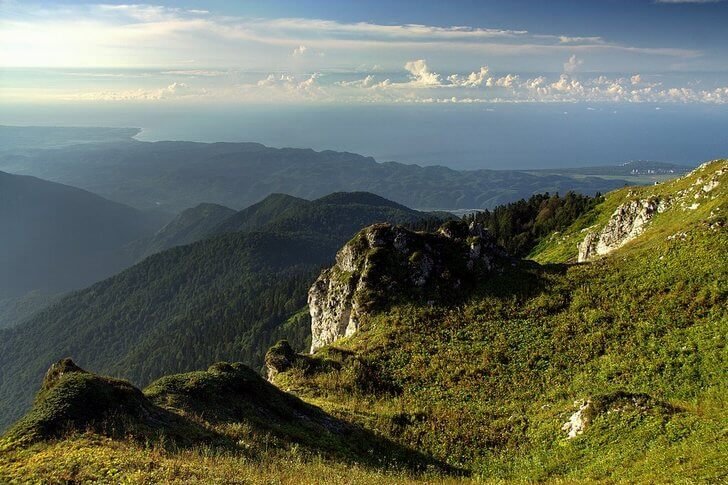
New Athos cave
Karst formation on the slope of the Iverskaya mountain, discovered in 1961. The cave is 3 km long and 183 meters deep. 10 halls and galleries filled with grandiose stalactites and stalagmites are available for inspection. Musical concerts are sometimes held in one of the grottoes. The New Athos cave is one of the most visited memorable places in Abkhazia, along with the monastery of the same name.
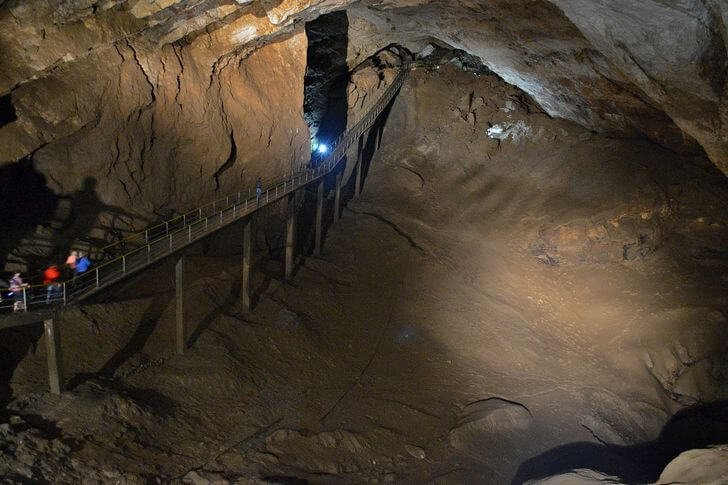
Alpine meadows of Abkhazia
One of the most picturesque natural areas of Abkhazia are alpine meadows, which begin at Auadkhara at an altitude of 1600 meters. This place is very attractive for experienced trekking enthusiasts, as the path here is quite difficult and only experienced tourists can do it. The meadows are wide green valleys with small rivers, waterfalls and lakes spread among majestic mountains.

Waterfall "Girl's Tears"
The waterfall is located on the way to Lake Ritsa on the left side of the highway. Tour buses and independent tourists make a stop near it. Every traveler seeks to tie a colored ribbon as a keepsake. The stream is associated with a legend about a girl who fell in love with a mountain spirit. She was killed by an evil sorceress (or mermaid). Allegedly, these are the tears of the beauty turned into a waterfall.
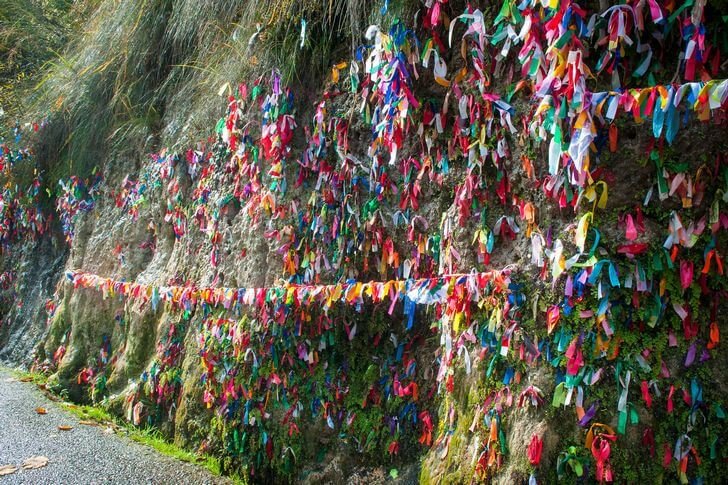
New Athos waterfall
New Athos waterfall is an artificial structure erected by New Athos monks to protect against floods. The height of the hydraulic structure is about 9 meters, the length is 21 meters, it is equipped with locks and holes for water drainage. It is convenient to admire the falling stream from the observation deck located opposite, from here you can also take spectacular photos.

Geg waterfall
The water cascade is located on the slopes of the Gagra Range at an altitude of more than 500 meters. Its height, according to various estimates, ranges from 50 to 70 meters. The waterfall featured in the famous film about Sherlock Holmes: a fight scene between the detective and his antagonist, Professor Moriarty, was filmed here. He also flashes in a couple of other Soviet films. In the Abkhaz language, the waterfall is called "Zou".
